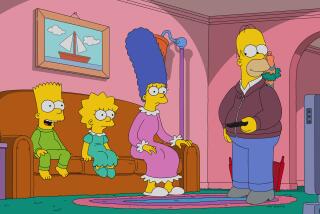Simpsons’ summer adventure
- Share via
LAST Saturday, the tiny Vermont town of Springfield (pop. 9,084) celebrated its biggest news since local hero Isaac Fischer Jr. got a patent for sandpaper back in 1834. This time around the excitement was decidedly more glamorous, right down to rolling out the red carpet: the premiere of “The Simpsons Movie,” an honor that involved beating out 13 other U.S. cities with the same name. The Simpsons, of course, live in a place called Springfield and now Vermonters are gleefully claiming the Velveeta-hued family as their own.
Yeah, right, like Bart Simpson could find the sixth smallest state on a map.
As fitting as it might be for the birthplace of sandpaper to be home to Homer, Marge, Bart, Lisa and Maggie, the denizens of their cartoon town live and die right here in Southern California -- in Century City to be more precise, where the film that opens nationwide this Friday was assembled over the last 43 months (yes, that would be nearly four years).
Go to the 20th Century Fox lot and ask for directions to Pamela Anderson’s old trailer, the one she used on “Busted.” That show’s name is still on the door but inside you’ll find the animators who draw the bug-eyed icons of the longest-running comedy in the history of television. Walk out of that trailer, wander north and look around for a giant yellow hand holding a pink-frosted doughnut the size of tractor tire. Across from it is a shabby little room with cheap furniture, a balky air conditioner and coffee stains on the floor. This is the writer’s room for Homer’s odyssey, which began 18 years ago, and the town square of the true Simpsonian Springfield.
On a recent afternoon, three stalwarts of “The Simpsons’ ” creative team gave a tour of the room. There was James L. Brooks, the wisecracking and gentle rabbi/executive producer of “The Simpsons” since Day 1 -- as close as you get to a conscience for the show; Al Jean, the writer and producer who has anxiously worked seven-day weeks for a year to finish the film and keep the series going; and Richard Sakai, the taciturn producer who streamlined the animation process, making it possible to even contemplate, for the first time in the show’s history, doing a film and television series at the same time.
The tour didn’t take long. Jean: “This is the chair where I proposed to my wife, which is either sweet or pretty pathetic.” Brooks: “This poster on the wall is a famous thing -- our touchstone. It shows all the characters in Springfield.” Sakai: “Yeah, that poster is great.” Jean: “They spent all the money on animation, not on the room.”
Wow, heady stuff.
But then again, the same things that make “The Simpsons” so fundamentally unglamorous are also what make the franchise so special. The actors who play the main characters can walk down the street without being recognized. The characters on the screen are, in the words of Jean, “drawn in a very simple style.” In the writer’s room the pencils last longer than most of the scribes. But all of this keeps the humor agile and surprisingly edgy for an enterprise verging on voting age.
One of the most interesting traits of this studio-lot Springfield is that the people logging the longest hours often lose sight of the iconic nature of their creation: “You get working here and you forget that it’s seen all over the world -- until you go all over the world,” Jean said. “You just do your job here and try to make the people you work with laugh. And you forget. Then it’s like, ‘Oh right, this is a cultural phenomenon.’ ”
Making bigger better
On another morning, Brooks slid into a booth at the Hotel Bel-Air’s restaurant and ordered some poached eggs and a heaping bowl of blueberries. He was asked if there was apprehension about making the movie -- after all, the TV show is largely defined by its comparatively primitive art, of-the-moment humor and a certain humility. Did he fret that super-sizing it would sabotage its singular charm?
“Just for about 16 years,” he deadpanned. “I think everything you mentioned we cared about enormously. So with the movie we started with the old gang of writers and we kept on shifting our personalities and new people would come in.... Some of us were always at the table no matter what and it was a very long period of time. A lot of it was to shake loose of what everyone was saying about the show” -- here he put on the voice of a haughty and wheezy critic -- ‘This show, after all these years....’ The main thing is we wanted to have fun. And make a movie we could be proud of.”
The movie has the same artistic sensibility of the series but with grander backgrounds, nuanced lighting and shadows, more colors and a scope that would be impossible on a TV production budget. It’s not 3-D, Pixar-style animation, but the film does have a depth and sweep that goes beyond the 2-D art of the series. Call it 2.5-D. Jean specifically praised the film’s director, David Silverman, and the assistant directors for keeping the big-screen universe in rhythm with the television show while increasing the “scope and effect and ambition” of the familiar visuals. “They kept it to what we all expect but just made it more.”
In one scene, where the enraged, torch-bearing residents of Springfield march toward the Simpsons household with blood in their eyes, you can plainly see the benefits of the newfound elbow room a big screen offers.
But there are more bonuses, like 100 speaking roles (including one surprise appearance by an Oscar-winning actor, and the death of the rock band Green Day, who perform a floating concert for the American idiots of Springfield) and the new frontiers offered by PG-13: a cartoon penis, Homer giving the finger, a character who uses her breasts to deliver life advice and a passionate lip-lock between two male cops. It makes for an interesting summer: The Simpsons are flashing genitalia and John Waters is watching a PG version of “Hairspray” at the multiplex.
“We wanted to do some things we couldn’t do on TV and you know we had to get that required PG-13,” said Matt Groening, the cartoonist who 20 years ago created “The Simpsons.” “There’s also a smidgen of political satire and, at the behest of James L. Brooks, the movie goes for moments of real emotion. And it succeeds, I believe.”
The plot finds Homer making a horrific error in judgment that angers his family and endangers all of Springfield. The lapse is somewhat understandable -- he was in a rush to get a free doughnut -- but it sets into motion a quest by Homer to reclaim his family and right his wrong. There are moments of sublime physical comedy (Bart’s nude skateboard ride is unforgettable), but the tender scenes are what pack a wallop: Marge taping a wrenching farewell video message to her husband; an envious Bart watching his neighbor tenderly tuck his sons into bed; Lisa pining for the new boyfriend lost to her because of Homer’s sins.
“It’s amazing,” Brooks said, “seeing them on the screen and really feeling this stuff. That speaks to the nature of these characters.”
Birth and rebirth
“The Simpsons” were born in the lobby of Brooks’ office much the way babies in sitcoms are delivered in the back of taxis. Groening had a 1986 meeting scheduled with Brooks to create an animated “bumper” to bracket commercial breaks on Fox’s long-defunct “The Tracey Ullman Show” (Brooks was the show’s producer). Groening roughed out a sketch of a surly looking family, which resembles the Simpsons of today about as much as Bizarro resembles Superman.
“Fox was the fourth network, nobody was watching, it was a show that nobody cared about. We decided to have little animation bumpers, mostly without dialogue,” Brooks recalled. “Matt’s [drawings] were crude but wonderful -- one of those strokes from heaven. In 10 minutes he basically drew what these guys are.”
The Simpsons got their own series in 1989 and within three years the show was a monumental merchandising empire, with kids in Third World countries sporting surplus “Don’t have a cow, man!” T-shirts. And the show just kept on going and going, thanks in large part to characters that never age and a cast, hidden behind animation, who don’t wear on viewers the way, say, the visibly uninterested stars of “MASH” did after a decade in the same tents. “We didn’t have that last season of ‘Leave it to Beaver’ where the Beav was like 17 and acting like a third-grader,” Jean said.
Die-hard “Simpsons” fans will quibble about quality: The show is still good, but nothing matches seasons three through five, the show’s “golden age.” Jean was the show-runner for seasons three and four, but he’s just as proud of the current run. In the last year, the show hit episode No. 400, won the Emmy for best animated program, the Writers Guild Award for best animated script and a People’s Choice Award for cartoons.
And Jean thinks the film can only help the series. “I think it will re-energize the show. And the excitement right now reminds me of how it was in those early days when it was so huge you couldn’t get away from it. I never thought we would relive that.”
There’s already talk of a sequel and the new animation process cooked up by Sakai (courtesy of some cool computer toys) has created a dynamic whereby gags can be written in the morning, voiced in the afternoon and wedded to a rough cartoon storyboard by evening -- though Brooks will tell you the best thing going in his West Coast Springfield is the low-tech tradition of caring about the characters in the poster and the people in the room.
“The great thing about a television series that’s working is you get community,” Brooks said. “There’s a number of people who have been there from the beginning and we also have people on staff who were watching the show when they were 8. And in a business that goes up and down, that gives you something rare, a security that makes people want to serve it. What that gives you is community, your own little town.”
More to Read
The complete guide to home viewing
Get Screen Gab for everything about the TV shows and streaming movies everyone’s talking about.
You may occasionally receive promotional content from the Los Angeles Times.






